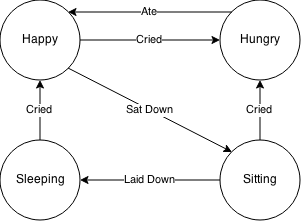Functional data structure are kind of a big deal, but what exactly makes them “functional”? After all, isn’t any data structure that works functional? Sorry, bad joke. In fact, a functional data structure is one that, like functional code itself, does not mutate state. Instead, functional data data structures are modified by copying the affected cells of a data structure and making changes in the copy. Okay you say, what does this buy me over a Vector?
To illustrate some of the advantages to functional data structures lets walk through the linked list. Linked lists are, as Chris Okasaki points out in his excellent book Purely Functional Data Structures, stacks. That is to say, you can add elements to the head of a list (push), or read off the head (pop). Both structures are head-optimized. So, what does a basic linked list implementation actually look like in Scala?
abstract class List_
case object Nil_ extends List_
case class Cons_[A](head: A, tail: List_) extends List_
object List_{
def::[A](data: A, ls: List_) = Cons_(data, ls)
def isEmpty(ls: List_) = ls match{
case Nil_ => true
case _ => false
}
def head(ls: List_) = ls match{
case Cons_(h, t) => Some(h)
case _ => None
}
def tail(ls: List_) = ls match{
case Cons_(_, t: Cons_) => Some(t)
case _ => None
}
}In fairly idiomatic Scala, you’ll start with a base interface List, then provide the empty case Nil. After that, every List is simply a bit of data added to the head of another List, aka Cons. Now lets imagine we want to append two lists together. With a mutable list you can just take the tail element of the list & set it as the head of the second list. However, with a functional list we don’t want to mutate the other list. So, how do we concatenate both lists without mutating either list?
def append(as: List_, bs: List_): List_ = as match{
case Nil => bs
case Cons_(h, t) => Cons_(h, append(t,bs))
}As you can see, instead of modifying either list I’ve walked both lists & constructed a third list from their elements. It’s the order of the traversal, from list A’s head -> list B’s tail that ensures the concatenation is in the correct order. There are a few other helper functions like foldLeft and reverse that we’ll need in a moment, so lets add them as well:
def foldLeft[T, A](ls: List_, seed: T)(f: (A, T)=> T): T =
ls match{
case Nil_ => seed
case Cons_(h: A, t) => foldLeft(t, f(h, seed))(f)
case _ => seed
}
def reverse[A](ls: List_) = ls match{
case Nil_ => ls
case Cons_(h:A, t) => foldLeft[List_, A](ls, Nil_)((x, seed) =>{
seed match{
case Nil_ => Cons_[A](h, Nil_)
case Cons_(a:A, _) => Cons_[A](a, seed)
}
})
}Aside from the ugly syntax (easy enough to fix!) this should look somewhat similar to the standard library. Fold Left is still an eager tail-recursive fold, and reverse returns the same elements in opposite order.
Now that we have a solid linked list implementation, lets move one to creating everyone’s favorite FIFO structure, the queue.
Unlike stacks, which are great for parsing & similar algorithms, queues are well-suited for algorithms requiring time-ordering such as processing instructions in the order they were issued. In an imperative setting Queue’s are often implemented using an Array or Vector with pointers to the current head & tail held internally. However, since this implementation relies exclusively on mutation, it’s not going to suffice for our functional queue. Instead, we’ll implement the queue as a pair of lists. The following code illustrates how to construct a basic functional queue:
case class Queue_[A](f: List_, r: List_)
object Queue_{
def isEmpty(q: Queue_[_]) = q match{
case Queue_(Nil_, Nil_) => true
case _ => false
}
def enQ[A](a: A, q: Queue_[A]) = Queue_(q.f, Cons_(a, q.r))
def deQ[A](q: Queue_[A]): (Option[A], Queue_[A]) = {
q match{
case x if isEmpty(x) => (None, q)
case Queue_(_Nil, x) => {
val newF = List_.reverse(x)
(List_.head(newF), Queue_(List_.tail(newF), Nil_))
}
case Queue_(f, r) =>
}
}
}Now that’s certainly more interesting than just a plain linked list. Thanks to the extended List implementation I’m able to model the queue as two lists which swap places whenever the front (f) is empty. This means either enQ or deQ will be O(n) in the worst case since it will require a full traversal to preserve ordering. In my example, I chose to provide an O(1) insertion and leave O(n) worst case for removal. You’d need to profile or at least understand your workload better to determine whether this makes sense for a particular use case.
For more reading I really can’t recomend Chris Okasaki’s book enough, but Functional Programming In Scala is also a great resource. Good luck & feel free to send me an email with any questions.

